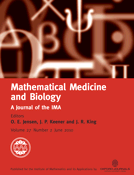-
Views
-
Cite
Cite
R. D. O'Dea, S. L. Waters, H. M. Byrne, A multiphase model for tissue construct growth in a perfusion bioreactor, Mathematical Medicine and Biology: A Journal of the IMA, Volume 27, Issue 2, June 2010, Pages 95–127, https://doi.org/10.1093/imammb/dqp003
Close - Share Icon Share
Abstract
The growth of a cell population within a rigid porous scaffold in a perfusion bioreactor is studied, using a three-phase continuum model of the type presented by Lemon et al. (2006, Multiphase modelling of tissue growth using the theory of mixtures. J. Math. Biol., 52, 571–594) to represent the cell population (and attendant extracellular matrix), culture medium and porous scaffold. The bioreactor system is modelled as a 2D channel containing the cell-seeded rigid porous scaffold (tissue construct) which is perfused with culture medium. The study concentrates on (i) the cell–cell and cell–scaffold interactions and (ii) the impact of mechanotransduction mechanisms on construct composition. A numerical and analytical analysis of the model equations is presented and, depending upon the relative importance of cell aggregation and repulsion, markedly different cell movement is revealed. Additionally, mechanotransduction effects due to cell density, pressure and shear stress-mediated tissue growth are shown to generate qualitative differences in the composition of the resulting construct. The results of our simulations indicate that this model formulation (in conjunction with appropriate experimental data) has the potential to provide a means of identifying the dominant regulatory stimuli in a cell population.





